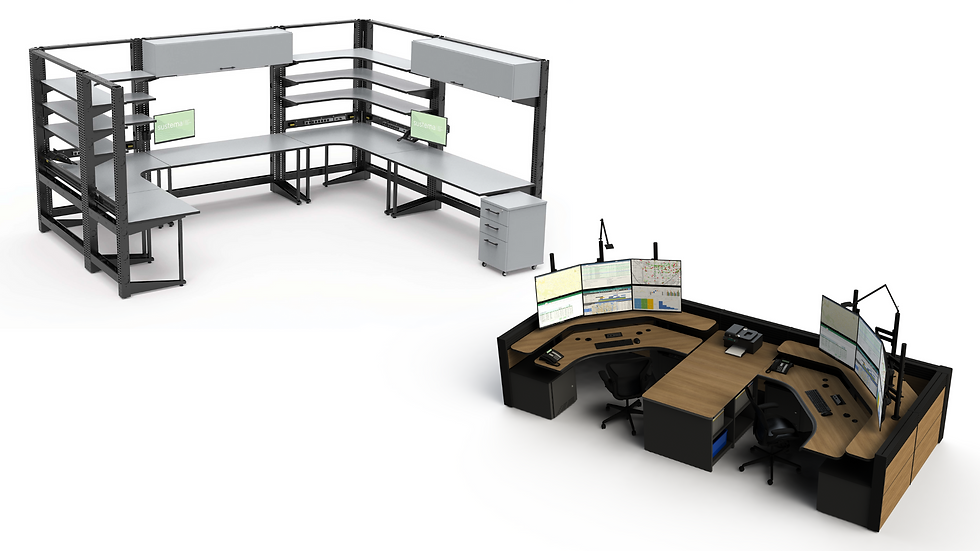IT Workbenches vs. Control Room Consoles: What’s the Difference and When to Use Each?
- Axel Trujillo

- Jul 29
- 2 min read

When designing a mission-critical environment, whether it’s a 911 dispatch center, transit control room, or utility operations hub, selecting the right furniture is more than a matter of aesthetics. It’s about performance, compliance, and long-term reliability. One of the most common points of confusion we see is the difference between IT workbenches and control room consoles.
While both serve technical environments, they are built for very different purposes. Choosing the wrong one can lead to ergonomic issues, compliance failures, and costly retrofits.
Let’s break it down.
What Is an IT Workbench?
An IT workbench is a modular, often industrial-style workstation designed for:
Equipment servicing
Hardware testing
Cable assembly
Back-office IT tasks
Key Features:
ESD protection for sensitive electronics
Adjustable shelving and tool storage
Basic cable management
Durable surfaces for handling equipment
These are ideal for environments like server rooms, repair labs, or staging areas, not for 24/7 operator use.
What Is a Control Room Console?
A control room console is purpose-built for continuous, high-stakes operations. Think 911 dispatchers, transit control operators, or emergency response coordinators.
Key Features:
24/7 ergonomic design (sit-stand, monitor arms, soft edges)
Integrated cable and power management
Compliance with R56 grounding standards
UL/CSA certified components
Custom layouts for multi-operator workflows
These consoles are engineered to reduce fatigue, improve focus, and support mission-critical performance.
Key Differences at a Glance
Feature | IT Workbench | Control Room Console |
Primary Use | Equipment servicing | Real-time monitoring |
Ergonomics | Basic | Advanced (24/7 use) |
Cable Management | Moderate | High-performance |
Compliance | ESD, UL | R56, UL/CSA |
Customization | Modular | Highly tailored |
User Type | IT technicians | Dispatchers, operators |
When to Use Each
Use an IT Workbench when:
You’re outfitting a server room or repair station.
Operators are not seated for long periods.
You need modularity and tool access.
Use a Control Room Console when:
Operators work in shifts around the clock.
You need ergonomic support for long sessions.
Compliance with safety and grounding standards is required.
You’re designing a 911 center, SOC, TOC, or NOC.
Common Mistakes to Avoid
Using IT workbenches in 24/7 environments: This leads to operator fatigue and potential injury.
Overlooking compliance: Failing to meet R56 or UL/CSA standards can delay inspections or void warranties.
Assuming one-size-fits-all: Control rooms require tailored layouts based on workflow, sightlines, and technology.
How We Help You Choose the Right Solution
At Sustema, we’ve helped hundreds of public safety agencies, utilities, and transportation authorities design and furnish their control rooms. Our team works closely with you to:
Assess your operational needs
Ensure compliance with all relevant standards
Deliver ergonomic, future-proof solutions
Whether you need a single IT bench or a fully integrated control room, we’re here to guide you every step of the way.
Need help designing your control room?
Choosing between an IT workbench and a control room console isn’t just a technical decision, it’s a strategic one. The right choice improves operator performance, ensures compliance, and protects your investment. Contact our specialists today to get started.



Comments